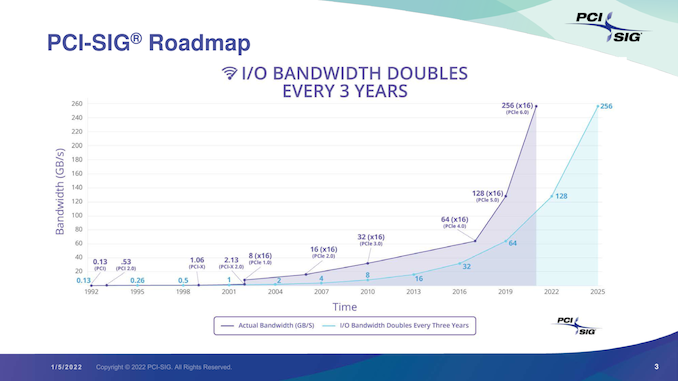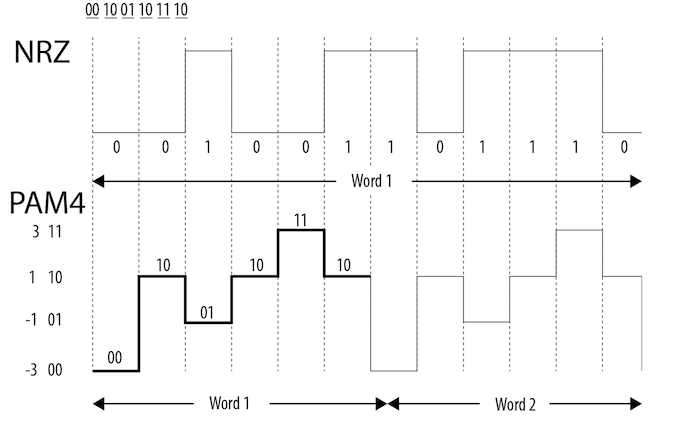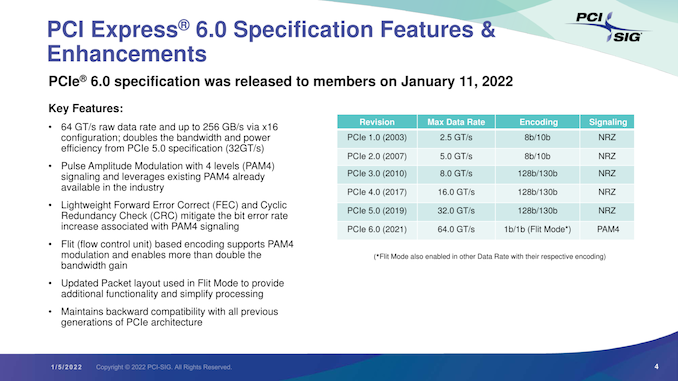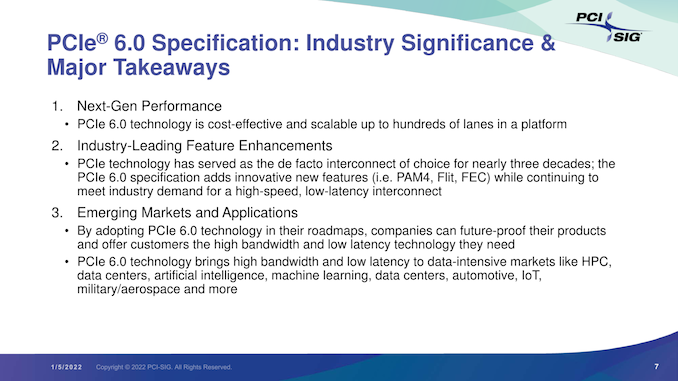PCI Express 6.0 Specification Finalized: x16 Slots to Reach 128GBps
by Ryan Smith on January 11, 2022 12:00 PM EST
This morning the PCI Special Interest Group (PCI-SIG) is releasing the much-awaited final (1.0) specification for PCI Express 6.0. The next generation of the ubiquitous bus is once again doubling the data rate of a PCIe lane, bringing it to 8GB/second in each direction – and far, far higher for multi-lane configurations. With the final version of the specification now sorted and approved, the group expects the first commercial hardware to hit the market in 12-18 months, which in practice means it should start showing up in servers in 2023.
First announced in the summer of 2019, PCI Express 6.0 is, as the name implies, the immediate follow-up to the current-generation PCIe 5.0 specification. Having made it their goal to keep doubling PCIe bandwidth roughly every 3 years, the PCI-SIG almost immediately set about work on PCIe 6.0 once the 5.0 specification was completed, looking at ways to once again double the bandwidth of PCIe. The product of those development efforts is the new PCIe 6.0 spec, and while the group has missed their original goal of a late 2021 release by mere weeks, today they are announcing that the specification has been finalized and is being released to the group’s members.
As always, the creation of an even faster version of PCIe technology has been driven by the insatiable bandwidth needs of the industry. The amount of data being moved by graphics cards, accelerators, network cards, SSDs, and other PCIe devices only continues to increase, and thus so must bus speeds to keep these devices fed. As with past versions of the standard, the immediate demand for the faster specification comes from server operators, whom are already regularly using large amounts of high-speed hardware. But in due time the technology should filter down to consumer devices (i.e. PCs) as well.
By doubling the speed of a PCIe link, PCIe 6.0 is an across-the-board doubling of bandwidth rates. X1 links move from 4GB/second/direction to 8GB/second/direction, and that scales all the way up to 128GB/second/direction for a full x16 link. For devices that are already suturing a link of a given width, the extra bandwidth represents a significant increase in bus limits; meanwhile for devices that aren’t yet saturating a link, PCIe 6.0 offers an opportunity to reduce the width of a link, maintaining the same bandwidth while bringing down hardware costs.
| PCI Express Bandwidth (Full Duplex: GB/second/direction) |
||||||||
| Slot Width | PCIe 1.0 (2003) |
PCIe 2.0 (2007) |
PCIe 3.0 (2010) |
PCIe 4.0 (2017) |
PCIe 5.0 (2019) |
PCIe 6.0 (2022) |
||
| x1 | 0.25GB/sec | 0.5GB/sec | ~1GB/sec | ~2GB/sec | ~4GB/sec | 8GB/sec | ||
| x2 | 0.5GB/sec | 1GB/sec | ~2GB/sec | ~4GB/sec | ~8GB/sec | 16GB/sec | ||
| x4 | 1GB/sec | 2GB/sec | ~4GB/sec | ~8GB/sec | ~16GB/sec | 32GB/sec | ||
| x8 | 2GB/sec | 4GB/sec | ~8GB/sec | ~16GB/sec | ~32GB/sec | 64GB/sec | ||
| x16 | 4GB/sec | 8GB/sec | ~16GB/sec | ~32GB/sec | ~64GB/sec | 128GB/sec | ||
PCI Express was first launched in 2003, and today’s 6.0 release essentially marks the third major revision of the technology. Whereas PCIe 4.0 and 5.0 were “merely” extensions to earlier signaling methods – specifically, continuing to use PCIe 3.0’s 128b/130b signaling with NRZ – PCIe 6.0 undertakes a more significant overhaul, arguably the largest in the history of the standard.
In order to pull of another bandwidth doubling, the PCI-SIG has upended the signaling technology entirely, moving from the Non-Return-to-Zero (NRZ) tech used since the beginning, and to Pulse-Amplitude Modulation 4 (PAM4).
As we wrote at the time that development on PCIe 6.0 was first announced:
PAM4 itself is not a new technology, but up until now it’s been the domain of ultra-high-end networking standards like 200G Ethernet, where the amount of space available for more physical channels is even more limited. As a result, the industry already has a few years of experience working with the signaling standard, and with their own bandwidth needs continuing to grow, the PCI-SIG has decided to bring it inside the chassis by basing the next generation of PCIe upon it.
The tradeoff for using PAM4 is of course cost. Even with its greater bandwidth per Hz, PAM4 currently costs more to implement at pretty much every level, from the PHY to the physical layer. Which is why it hasn’t taken the world by storm, and why NRZ continues to be used elsewhere. The sheer mass deployment scale of PCIe will of course help a lot here – economies of scale still count for a lot – but it will be interesting to see where things stand in a few years once PCIe 6.0 is in the middle of ramping up.
Meanwhile, not unlike the MLC NAND in my earlier analogy, because of the additional signal states a PAM4 signal itself is more fragile than a NRZ signal. And this means that along with PAM4, for the first time in PCIe’s history the standard is also getting Forward Error Correction (FEC). Living up to its name, Forward Error Correction is a means of correcting signal errors in a link by supplying a constant stream of error correction data, and it’s already commonly used in situations where data integrity is critical and there’s no time for a retransmission (such as DisplayPort 1.4 w/DSC). While FEC hasn’t been necessary for PCIe until now, PAM4’s fragility is going to change that. The inclusion of FEC shouldn’t make a noticeable difference to end-users, but for the PCI-SIG it’s another design requirement to contend with. In particular, the group needs to make sure that their FEC implementation is low-latency while still being appropriately robust, as PCIe users won’t want a significant increase in PCIe’s latency.
It’s worth noting that FEC is also being paired with Cyclic Redundancy Checking (CRC) as a final layer of defense against bit errors. Packets that, even after FEC still fail a CRC – and thus are still corrupt – will trigger a full retransmission of the packet.
The upshot of the switch to PAM4 then is that by increasing the amount of data transmitted without increasing the frequency, the signal loss requirements won’t go up. PCIe 6.0 will have the same 36dB loss as PCIe 5.0, meaning that while trace lengths aren’t officially defined by the standard, a PCIe 6.0 link should be able to reach just as far as a PCIe 5.0 link. Which, coming from PCIe 5.0, is no doubt a relief to vendors and engineers alike.
Alongside PAM4 and FEC, the final major technological addition to PCIe 6.0 is its FLow control unIT (FLIT) encoding method. Not to be confused with PAM4, which is at the physical layer, FLIT encoding is employed at the logical level to break up data into fixed-size packets. It’s by moving the logical layer to fixed size packets that PCIe 6.0 is able to implement FEC and other error correction methods, as these methods require said fixed-size packets. FLIT encoding itself is not a new technology, but like PAM4, is essentially being borrowed from the realm of high-speed networking, where it’s already used. And, according to the PCI-SIG, it’s one of the most important pieces of the specification, as it’s the key piece to enabling (continued) low-latency operation of PCIe with FEC, as well as allowing for very minimal overhead. All told, PCI-SIG considers PCIe 6.0 encoding to be a 1b/1b encoding method, as there’s no overhead in the data encoding itself (there is however overhead in the form of additional FEC/CRC packets).
As it’s more of an enabling piece than a feature of the specification, FLIT encoding should be fairly invisible to users. However, it’s important to note that the PCI-SIG considered it important/useful enough that FLIT encoding is also being backported in a sense to lower link rates; once FLIT is enabled on a link, a link will remain in FLIT mode at all times, even if the link rate is negotiated down. So, for example, if a PCIe 6.0 graphics card were to drop from a 64 GT/s (PCIe 6.0) rate to a 2.5GT/s (PCIe 1.x) rate to save power at idle, the link itself will still be operating in FLIT mode, rather than going back to a full PCIe 1.x style link. This both simplifies the design of the spec (not having to renegotiate connections beyond the link rate) and allows all link rates to benefit from the low latency and low overhead of FLIT.
As always, PCIe 6.0 is backwards compatible with earlier specifications; so older devices will work in newer hosts, and newer devices will work in older hosts. As well, the current forms of connectors remain supported, including the ubiquitous PCIe card edge connector. So while support for the specification will need to be built into newer generations of devices, it should be a relatively straightforward transition, just like previous generations of the technology.
Unfortunately, the PCI-SIG hasn’t been able to give us much in the way of guidance on what this means for implementations, particularly in consumer systems – the group just makes the standard, it’s up to hardware vendors to implement it. Because the switch to PAM4 means that the amount of signal loss for a given trace length hasn’t gone up, conceptually, placing PCIe 6.0 slots should be about as flexible as placing PCIe 5.0 slots. That said, we’re going to have to wait and see what AMD and Intel devise over the next few years. Being able to do something, and being able to do it on a consumer hardware budget are not always the same thing.
Wrapping things up, with the PCIe 6.0 specification finally completed, the PCI-SIG tells us that, based on previous adoption timelines, we should start seeing PCIe 6.0 compliant hardware hit the market in 12-18 months. In practice this means that we should see the first server gear next year, and then perhaps another year or two for consumer gear.
Source: PCI-SIG



















77 Comments
View All Comments
ReviewerOfThings - Tuesday, January 11, 2022 - link
Thanks for the article :) The chart at the beginning (from PCI-SIG) seems to have confusing terminology between "actual" and 'IO" bandwidth.Yojimbo - Tuesday, January 11, 2022 - link
So 19 months between 4 and 5 and 31 months between 5 and 6.DougMcC - Tuesday, January 11, 2022 - link
Probably unsurprising given the bigger changes in 6, and the whole, you know, global pandemic thing throwing processes into disarray.Targon - Tuesday, January 11, 2022 - link
From a practical standpoint, video cards are currently BARELY beyond the limits of PCIe 3.0, and nowhere near needing PCIe 5.0 speeds. There are some things that could make use of it, primarily NVMe SSDs, but that's pretty much it. Multi-GPU or linking multiple PCIe devices to each other via the PCIe bus rather than using a bridge connector would be one of the few obvious uses.Servers are the place where there will be a big benefit.
FreckledTrout - Tuesday, January 11, 2022 - link
In the consumer space. In the data center this will be huge.willis936 - Tuesday, January 11, 2022 - link
This isn't about frames per second, it's about getting data in and out of CPUs. 8x PCIe 6.0 lanes can be broken out to a lightning fast NVMe array, two GPUs, and high speed networking. No need to cut down on bandwidth or lanes for each individual device because you can turn those 8 CPU lanes into 32 gen 4 lanes in the chipset.minde - Tuesday, January 11, 2022 - link
SSD s real speed is only 2 GB/s with pcie 3x4, pcie 4x4Qasar - Tuesday, January 11, 2022 - link
i just would like to see more lanes on the desk top, like x99 hadTheinsanegamerN - Thursday, January 13, 2022 - link
Or AMD's own 990fx chipset, 40 PCIe lanes......Qasar - Thursday, January 13, 2022 - link
heh, forgot about that one. but looking for something much newer, maybe am5 ?ive looked into TR, but even an inexpensive board, and a 16 core, i easily 2k.... not in the cards right now.